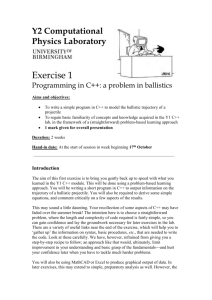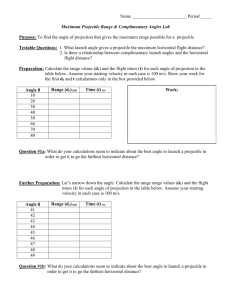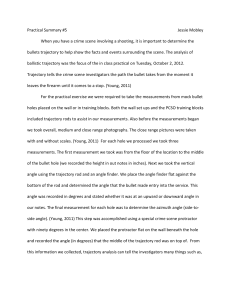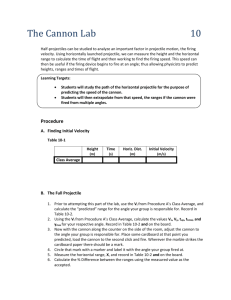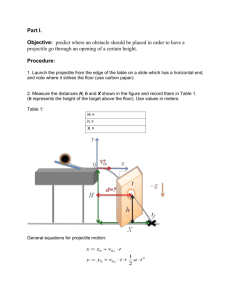Trajectory Analysis – PDF, 158 kb
advertisement
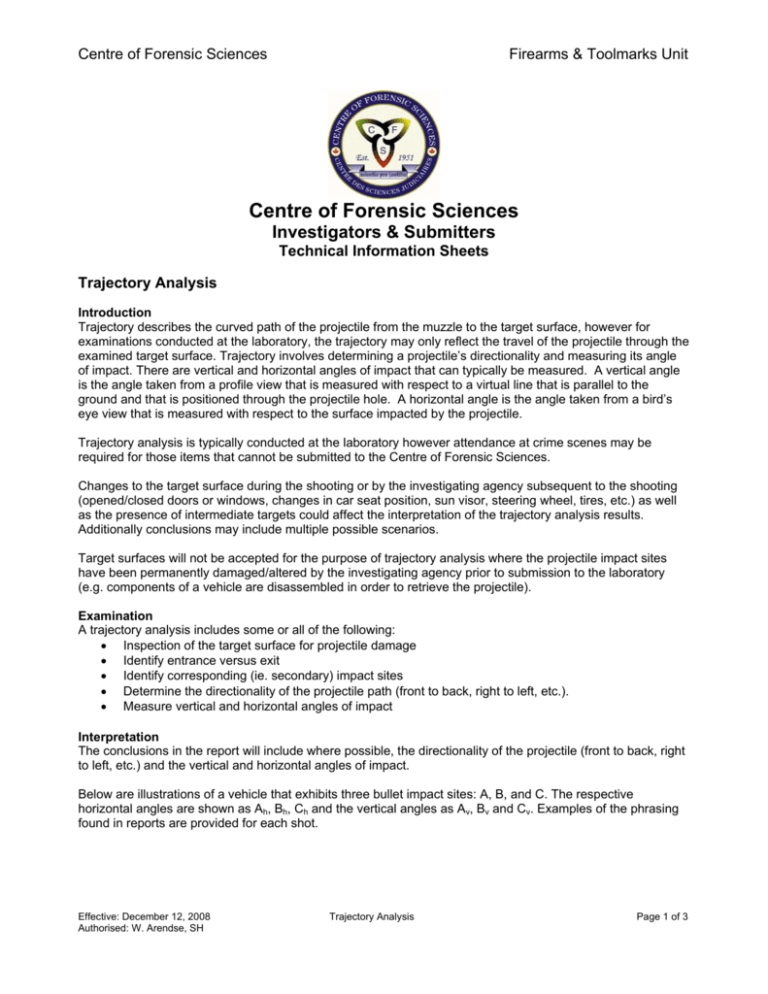
Centre of Forensic Sciences Firearms & Toolmarks Unit Centre of Forensic Sciences Investigators & Submitters Technical Information Sheets Trajectory Analysis Introduction Trajectory describes the curved path of the projectile from the muzzle to the target surface, however for examinations conducted at the laboratory, the trajectory may only reflect the travel of the projectile through the examined target surface. Trajectory involves determining a projectile’s directionality and measuring its angle of impact. There are vertical and horizontal angles of impact that can typically be measured. A vertical angle is the angle taken from a profile view that is measured with respect to a virtual line that is parallel to the ground and that is positioned through the projectile hole. A horizontal angle is the angle taken from a bird’s eye view that is measured with respect to the surface impacted by the projectile. Trajectory analysis is typically conducted at the laboratory however attendance at crime scenes may be required for those items that cannot be submitted to the Centre of Forensic Sciences. Changes to the target surface during the shooting or by the investigating agency subsequent to the shooting (opened/closed doors or windows, changes in car seat position, sun visor, steering wheel, tires, etc.) as well as the presence of intermediate targets could affect the interpretation of the trajectory analysis results. Additionally conclusions may include multiple possible scenarios. Target surfaces will not be accepted for the purpose of trajectory analysis where the projectile impact sites have been permanently damaged/altered by the investigating agency prior to submission to the laboratory (e.g. components of a vehicle are disassembled in order to retrieve the projectile). Examination A trajectory analysis includes some or all of the following: • Inspection of the target surface for projectile damage • Identify entrance versus exit • Identify corresponding (ie. secondary) impact sites • Determine the directionality of the projectile path (front to back, right to left, etc.). • Measure vertical and horizontal angles of impact Interpretation The conclusions in the report will include where possible, the directionality of the projectile (front to back, right to left, etc.) and the vertical and horizontal angles of impact. Below are illustrations of a vehicle that exhibits three bullet impact sites: A, B, and C. The respective horizontal angles are shown as Ah, Bh, Ch and the vertical angles as Av, Bv and Cv. Examples of the phrasing found in reports are provided for each shot. Effective: December 12, 2008 Authorised: W. Arendse, SH Trajectory Analysis Page 1 of 3 Centre of Forensic Sciences Firearms & Toolmarks Unit Cv=0° Vehicle illustration taken from http://www.ceco.net/autocad-car-blocks/cars1-autocad-blocks.html - illustrations have been modified to exhibit bullet impact sites • For Shot A: The defect located on the forward, passenger side of the hood was caused by a bullet traveling from the front passenger side towards the driver side at a horizontal angle of approximately 50 degrees to the vertical plane and in an upward direction at a vertical angle of approximately 45 degrees to the horizontal plane. • For Shot B: The defect located in the mid, driver side of the windshield was caused by a bullet traveling from the front passenger side towards the driver side at a horizontal angle of approximately 75 degrees to the vertical plane and in a downward direction at a vertical angle of approximately 60 degrees to the horizontal plane. • For Shot C: the defect located in the front, driver’s side door window was caused by a bullet traveling from the rear driver’s side towards the front passenger side at a horizontal angle of approximately 70 degrees to the vertical plane and perpendicular to the window at a vertical angle of approximately 0 degrees to the horizontal. Other conclusion phrasing may include: • The defect located in the front, passenger side window was caused by a bullet traveling from the front passenger side towards the back driver side of the vehicle. This defect is not suitable for impact angle measurements. • The two defects on the bottom of the front driver’s side window frame are not suitable for trajectory analysis. Glossary Horizontal angle of impact An angle that corresponds to a profile view of the bullet path and is measured from the horizontal plane Intermediate target The passage of a projectile(s) through an object before striking the primary target surface under examination Penetrate To enter an object and stay in it Perforate To pass all the way through an object Effective: December 12, 2008 Authorised: W. Arendse, SH Trajectory Analysis Page 2 of 3 Centre of Forensic Sciences Firearms & Toolmarks Unit Primary impact The first impact made by the projectile Secondary /tertiary/ etc impact The second, third etc impacts of a projectile after the first impact Trajectory The curved path of the projectile from the muzzle to the target surface Vertical angle of impact An angle that corresponds to an overhead view of the bullet path and is measured from the vertical plane Effective: December 12, 2008 Authorised: W. Arendse, SH Trajectory Analysis Page 3 of 3


